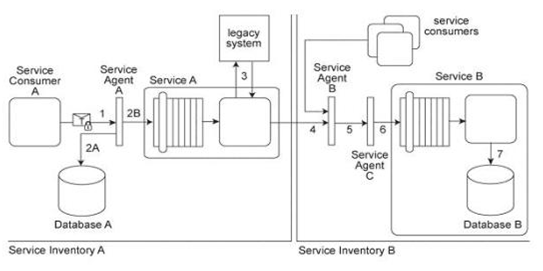Arcitura Education Exam S90.20 Topic 1 Question 25 Discussion
Topic #: 1
Service Consumer A sends a request message with an authentication token to Service A, but before the message reaches Service A, it is intercepted by Service Agent A (1). Service Agent A validates the security credentials and also validates whether the message is compliant with Security Policy A .If either validation fails, Service Agent A rejects the request message and writes an error log to Database A (2A). If both validations succeed, the request message is sent to Service A (2B). Service A retrieves additional data from a legacy system (3) and then submits a request message to Service B Before arriving at Service B, the request message is intercepted by Service Agent B (4) which validates its compliance with Security Policy SIB then Service Agent C (5) which validates its compliance with Security Policy B .If either of these validations fails, an error message is sent back to Service A .that then forwards it to Service Agent A so that it the error can be logged in Database A (2A). If both validations succeed, the request message is sent to Service B (6). Service B subsequently stores the data from the message in Database B (7). Service A and Service Agent A reside in Service Inventory A .Service B and Service Agents B and C reside in Service Inventory B .Security Policy SIB is used by all services that reside in Service Inventory B .Service B can also be invoked by other service consumers from Service Inventory B .Request messages sent by these service consumers must also be compliant with Security Policies SIB and B .Access to the legacy system in Service Inventory A is currently only possible via Service A, which means messages must be validated for compliance with Security Policy A .A new requirement has emerged to allow services from Service Inventory B to access the legacy system via a new perimeter service that will be dedicated to processing request messages from services residing in Service Inventory B .Because the legacy system has no security features, all security processing will need to be carried out by the perimeter service. However, there are parts of Security Policy A that are specific to Service A and do not apply to the legacy system or the perimeter service. Furthermore, response messages sent by the perimeter service to services from Service Inventory B will still need to be validated for compliance to Security Policy B and Security Policy SIB .How can the Policy Centralization pattern be correctly applied without compromising the policy compliance requirements of services in both service inventories?

Currently there are no comments in this discussion, be the first to comment!